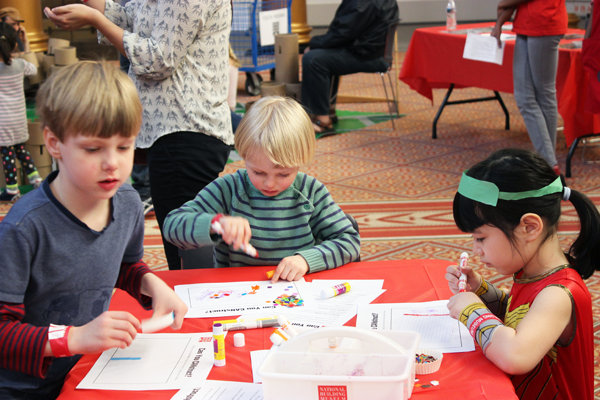Family Afternoon: Growing Community
 Free, drop in. All ages.
Free, drop in. All ages.
Explore how green space can be intentionally integrated into and around the built environment to help promote community and encourage civic engagement. Celebrate spring and the District's blossoming cherry trees while expanding your understanding of the impact nature has on the built world and its citizens.
Ongoing Activities:
- DESIGN and BUILD a parklet to add to the Great Hall inspired by the PARK(ing) Day movement
- DISCOVER the importance of green space in building community at partner tables in the Great Hall
- LISTEN to a spring inspired story and create a soft flower garden with your young learners
Ten (minute) Talks
11:30-11:50 am
Supporting Children's Interaction with Nature
Peggy Ashbrook
Learn about simple experiences in nature that can shape a child’s understanding of, our world with early childhood science educator and author, Peggy Ashbrook.
Peggy Ashbrook writes for the National Science Teachers Association‘s (NSTA) Early Years column in Science & Children and companion blog and is the author of Science Learning in the Early Years (2016 NSTA Press) and Science is Simple (2003, Gryphon House). She began teaching science to young children as a childcare provider in 1988. Peggy teaches children ages 2-5 in a variety of programs, mentors teachers in preK programs and schools, and provides professional development on early childhood science inquiry Her favorite place is where the worlds of early childhood and science learning overlap.
12-12:20 pm
Creating Community through Design
Spring 2017 Design Apprenticeship Program Participants
Youth and volunteers from the spring 2017 session of the Design Apprenticeship Program share how they transformed empty lot beside the Boys and Girls Club of Greater Washington's Richard England Clubhouse 14 in the Benning neighborhood. The teens worked to integrate neighborhood voices, ideas, and action.
The National Building Museum’s Design Apprenticeship Program brings together teens and professionals from across the D.C. metropolitan area to design and build full scale projects for the Museum and the city. The program meets over the course of 9 Saturdays in the fall or spring. For additional information, visit the Museum’s website.
The Design Apprenticeship Program is generously supported by: The Morris and Gwendolyn Cafritz Foundation; Herbert M. Franklin Teen Programs Fund; and The Butz Foundation.
The National Park Service talk scheduled for 12:30 pm has been cancelled.
We apologize for any inconvenience.
1-1:20 pm
What Difference do Gardens and Green Space Make in a Community?
Cindy Brown, Smithsonian Gardens
Hear how greening a community contributes to the shaping and preservation of American garden history with Cindy Brown, the Manager of Horticulture Collections Management and Education at Smithsonian Gardens.
Working in the field of horticulture since 1993, Cindy began her career in a nursery and serendipitously discovered the world of public gardens. Currently, her most exciting project is the development of Community of Gardens initiative, a website and mobile app designed to cultivate a deeper understanding, and appreciation of, the role gardens play in keeping communities healthy, happy, and connected. Cindy holds a BS in Gerontology from Lycoming College and an AAS in Horticulture from Northern Virginia Community College.
1:30-1:50 pm
Landscape Architecture: What is it, and why does it matter?
Stephanie Pankiewicz, ASLA, PLA
Discover the role landscape architects play in growing community from Stephanie Pankiewicz as she speaks about her experience in the profession.
Stephanie Pankiewicz, PLA, ASLA is a Partner and Landscape Architect with LandDesign, based out of the Washington DC area. Stephanie directs many of the firm’s large scale master planning projects, including long-range master planning to urban design solutions for some of the nation’s leading developers. As a creative design leader, she applies her knowledge by offering innovative approaches including state-of-the-art design tools to engage diverse stakeholders in building consensus and understanding. She enjoys working at a variety of scales throughout the design process, and remains uniquely involved in all stages of a project. Her experience includes urban design, park planning and design, community master plans, site planning, design guidelines and streetscapes, with an emphasis on utilizing green infrastructure techniques as storm water harvesting, roof gardens, stream restoration, native plants and natural treatment systems for bio-retention.
Founded in 1899, ASLA is the professional association for landscape architects in the United States, representing more than 15,000 members. The Society’s mission is to advance landscape architecture through advocacy, communication, education, and fellowship.
This program is offered as part of the National Cherry Blossom Festival®.
